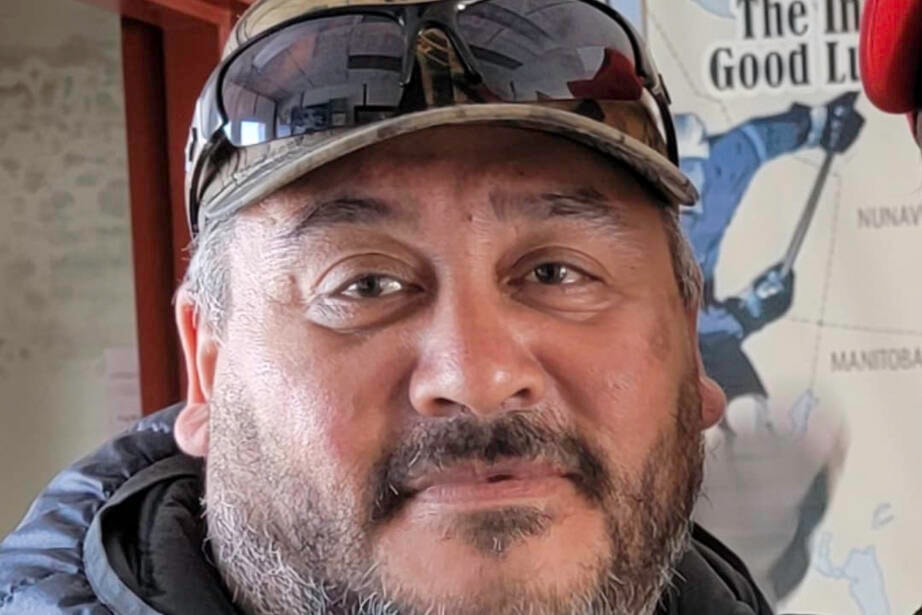ᑲᑎᓪᓚᑦᑖᓚᐅᖅᓯᒪᔪᓐᓃᖅᖢᑎᒃ ᐃᒻᒪᖄ ᐱᖓᓱᓂᒃ ᐅᑭᐅᓂᒃ ᓄᕙᒡᔪᐊᕐᓂᖅᑕᖃᓚᐅᖅᑳᖅᑎᓪᓗᒍ, ᑭᓯᐊᓂ ᐱᒻᒪᕆᐅᑎᑕᐅᓂᖏᑦ ᐃᓐᓇᑐᖃᐃᑦ ᐊᒻᒪᓗ ᒪᒃᑯᒃᑐᓪᓗ ᑲᑎᖃᑎᒌᑦᑎᐊᓚᐅᖅᑐᑦ ᐱᕗᓕ ᐊᒻᒪᓗ ᖃᒪᓂᕐᔪᐊᑉ ᑐᒃᑐᖏᓐᓂᒃ ᐊᐅᓚᑦᑎᔨᒃᑯᑦ ᑲᑎᒪᔨᖏᑦ ᑲᑎᑕᐃᓐᓇᖅᑎᓪᓗᒋ ᐅᐃᓂᐲᒃᒥ ᒪᐃᒥ.
ᑲᑎᒪᔩᑦ ᐃᓄᖕᓂᙶᖅᑐᑦ, ᐃᖅᑭᓕᖕᓂᙶᖅᑐᑦ ᐊᓪᓚᖓᔪᓂᒡᓗ ᓄᓇᓕᖕᓂᒃ, ᐃᓚᐅᖃᑕᐅᑉᓗᑎᒃ ᒐᕙᒪᒃᑯᑦ ᑭᒡᒐᖅᑐᐃᔨᖏᓪᓗ ᓇᓂᓗᒃᑖᖅ ᑐᒃᑐᖁᑎᓕᒃᑯᑦ ᐱᕗᓕ ᖃᒪᓂᕐᔪᐊᑉᓗ ᑐᒃᑐᖁᑎᖏᓐᓂᒃ, ᓄᓇᕗᒥᙶᓲᑦ, ᓄᓇᑦᑎᐊᕐᒥᓗ, ᒪᓂᑑᐸᒥᓗ ᐊᒻᒪᓗ ᓴᔅᑳᑦᑐᐊᓐᒥ.
ᓯᑖᓐᓕ ᐋᒡᔪᒃ ᑲᑎᒪᔨᐅᖃᑕᐅᔪᖅ ᑭᕙᓪᓕᕐᒥ ᐆᒪᔪᓕᕆᔨᕐᔪᐊᒃᑯᑦ ᑲᑎᒪᔨᖏᓐᓄᑦ. ᐅᖃᓚᐅᖅᑐᖅ ᐅᖃᐅᓯᖃᓗᐊᓚᐅᖅᑐᒡᒎᖅ ᐃᓐᓇᑐᖃᐃᑦ ᒪᒃᑯᒃᑐᓪᓗ ᐃᓚᐅᖃᑕᐅᔾᔫᒥᖁᑉᓗᒋᑦ ᑐᒃᑐᑦ ᒥᒃᓵᓄᑦ, ᐃᓕᓐᓂᐊᖅᑎᑦᑎᔪᒪᓂᕐᒧᑦ ᒪᒃᑯᒃᑐᓂᒃ ᐊᖑᓇᓱᖕᓂᒃᑯᑦ ᐊᒻᒪᓗ ᑐᒃᑐᖁᑎᒋᔭᐅᔪᑦ ᖃᓄᐃᙱᑦᑐᓐᓇᖁᑉᓗᒋᑦ.
“ᖃᑉᓰᓐᓇᕈᖅᐸᓪᓕᐊᓯᒪᓕᕐᒪᑕ ᑕᐃᒪᙵᓂ 1990-ᒥ ᐅᑉᓗᒥᒧᑦ,” ᑕᐃᒪᓐᓇ ᐅᖃᖅᖢᓂ ᐋᒡᔪᒃ, ᐅᖃᒃᑲᓐᓂᖅᖢᓂ ᖃᑉᓰᓐᓇᕈᕆᐊᖅᓯᒪᖅᑳᖅᖢᑎᒃ ᐃᓚᕚᓪᓕᓚᐅᖅᓯᒪᖕᒥᔪᒡᒎᖅ.
“ᐃᓄᐃᑦ ᑐᒃᑐᑦᑐᑑᖃᑦᑕᙱᒻᒪᑕ. ᑕᐃᒪᐅᔪᑦᑕᐅᖅ ᐊᓯᖏᑦ ᐆᒪᔪᑦ ᑎᕐᓕᐊᓲᑦ ᑐᒃᑐᑲᑕᒃᖢᑎᒃ, ᑕᐃᒪᐃᓕᐅᖃᑦᑕᕐᓂᖏᑦ ᖃᐅᔨᒪᓇᖅᑐᑦ ᓄᓇᖏᓐᓂᒃ. ᐅᖃᖃᑎᒌᒍᑕᐅᓯᒪᔪᑦ ᖃᓄᖅ ᓴᐳᓐᓂᐊᕈᓐᓇᕐᒪᖔᑉᑕ ᑐᒃᑐᓂᒃ.”
ᐊᒪᕈᐃᑦ, ᐊᒃᖤᐃᑦ ᐊᒻᒪᓗ ᖃᕝᕕᑦ ᑎᕐᓕᐊᖅᑎᐅᖕᒪᑕ ᑐᒃᑐᓂᒃ, ᑕᐃᒪᓐᓇ ᐅᖃᖅᖢᓂ. ᐊᒃᑐᖅᓯᓂᖃᖅᓯᒪᖕᒥᔪᖅ ᑐᒃᑐᑦ ᖃᑉᓰᓐᓇᕈᖅᓯᒪᓂᖏᓐᓄᑦ ᑐᒃᑐᑦ ᐃᓂᒋᕙᒃᑕᖏᑦ ᐊᒃᑐᖅᑕᐅᓂᖃᖃᑦᑕᖅᑎᓪᓗᒋᑦ ᐱᕙᓪᓕᐊᑎᑦᑎᔨᐅᔪᓄᑦ.
ᔮᓐ ᐊᑕᒥᓲᔅᑭ, ᑭᒡᒐᖅᑐᐃᔨᐅᔪᖅ ᓄᓇᑦᑎᐊᑉ ᒐᕙᒪᒃᑯᖏᓐᓂᒃ ᐱᕗᓕ ᖃᒪᓂᕐᔪᐊᑉ ᑐᒃᑐᖁᑎᖏᓐᓂᒃ ᐊᐅᓚᑦᑎᔨᒃᑯᑦ ᑲᑎᒪᔨᖏᓐᓄᑦ, ᐅᖃᓚᐅᖅᑐᖅ ᑐᓴᒐᒃᓴᓕᐊᖑᓯᒪᔪᒃᑯᑦ ᓄᓇᒥᒎᖅ ᑐᒃᑐᑦ ᓅᑲᑕᖕᓂᕆᕙᒃᑕᖏᑦ ᐃᑲᔫᑕᐅᕙᖕᒪᑕ ᑐᒃᑐᑦ ᐊᒥᓱᙳᖅᐸᓪᓕᐊᓂᕆᕙᒃᑕᖏᓐᓄᑦ. ᖃᒪᓂᕐᔪᐊᑉ ᑐᒃᑐᖏᑦ ᑭᖑᓪᓕᖅᐹᒃᑯᑦ ᓇᓚᐅᑦᑖᖅᑕᐅᓯᒪᔪᒃᑯᑦ 288,000-ᖑᓂᕋᖅᑕᐅᓚᐅᖅᑐᑦ 2017-ᒥ ᐱᕗᓕ ᑐᒃᑐᖁᑎᖏᑦ 103,000-ᒦᓐᓂᕋᖅᑕᐅᑉᓗᑎᒃ 2018-ᒥ.
“ᐊᑉᖁᑎᓕᐅᕌᖓᑉᑕ ᐊᒻᒪᓗ ᐊᓯᖏᓐᓂᒃ ᐱᖁᑎᕐᔪᐊᓂᒃ ᓅᑲᑕᒍᓐᓃᕐᓂᖅᓴᐅᖃᑦᑕᕐᒪᑕ, ᑐᒃᑐᓪᓗ ᖃᑉᓯᙳᕋᔭᕐᓂᖏᑦ ᐊᒃᑐᖅᑕᐅᓯᒪᓕᖅᐸᒃᖢᑎᒃ ,” ᑕᐃᒪᓐᓇ ᐅᖃᖅᖢᓂ.
ᐊᓯᖓᑦᑕᖅ ᐃᖢᐊᖏᓕᐅᕈᑕᐅᔪᖅ ᐅᖃᐅᓯᐅᓚᐅᖅᑐᖅ ᒪᐃᒥ ᑲᑎᒪᑎᓪᓗᒋᑦ ᐃᒃᐱᒋᔭᐅᑦᑎᐊᖃᑦᑕᖁᑉᓗᒋᑦ ᐊᖑᓇᓱᖕᓂᐅᕙᒃᑐᑦ.
ᑎᔅᒥᓐ ᓯᐃᓯ, ᐃᓕᓐᓂᐊᕐᕕᒡᔪᐊᕐᒥ ᐃᓕᓐᓂᐊᕌᓂᓵᓚᐅᖅᑐᖅᓯᐃᓯ ᐃᖅᑭᓖᑦ ᐃᖅᑭᓕᐅᖃᑎᒌᒃᑐᓂᒃ ᑐᑐᓕ ᓖᒃᒥ, ᒪᓂᑑᐸᒥ, ᑲᑎᒪᖃᑕᐅᓚᐅᖅᑐᖅ ᐊᒻᒪᓗ ᐅᖃᖅᖢᓂ ᐅᔾᔨᕈᓱᓚᐅᙱᑦᑐᕉᖅ ᖃᓄᖅ ᐱᒻᒪᕆᐅᑎᑦᑎᑎᒋᖕᒪᖔᑕ ᐃᓄᐃᑦ ᑐᒃᑐᖁᑎᒥᓂᒃ.
“ᐊᒥᓲᖕᒪᑕ ᐅᐃᕆᓯᒪᔪᑦ ᓄᓇᑉᑎᓐᓂᒃ, ᐃᓱᒪᔪᖓᓕ ᐃᓕᖅᑯᓯᕆᓚᐅᖅᑕᖅᐳᑦ ᐅᑎᖅᑎᓐᓇᓱᒐᔭᕈᑉᑎᒍᑦ ᒪᒃᑯᒃᑐᑉᑎᓐᓄᑦ ᐃᑲᔫᑕᐅᓇᔭᖅᑐᒃᓴᐅᔪᖅ ᐅᐃᕆᓯᒪᔪᓄᑦ, ᐊᒻᒪᓗ ᐃᑲᔫᑕᐅᓗᓂ ᑐᓴᖅᑎᑦᑎᓂᕐᒧᑦ ᑭᒃᑰᓂᑉᑎᓐᓄᑦ,” ᑕᐃᒪᓐᓇ ᐅᖃᖅᖢᓂ ᑐᓴᒐᒃᓴᑎᒍᑦ.
“ᑲᑎᒫᓂᖕᒪᑕ, ᐃᓕᑦᑎᒃᑲᓐᓂᕈᒪᓕᖅᑐᖓ ᑐᒃᑐᑦ ᒥᒃᓵᓄᑦ ᐊᒻᒪᓗ ᐅᕙᖓ ᑭᓇᐅᓂᒻᓄᑦ ᐃᖅᑭᓕᐅᑉᓗᖓ. ᑕᒪᒃᑯᐊ ᐃᑭᙳᑎᒃᑲᓄᑦ ᓴᖅᑭᑎᑦᑐᒪᔭᒃᑲ ᒪᒃᑯᖕᓂᖅᓴᓄᓪᓗ ᑕᑯᑎᓪᓗᒋᑦ ᑭᒃᑰᖕᒪᖔᑉᑕ − ᒪᓕᖃᑦᑕᖅᑐᒍᑦ ᑐᒃᑐᓂᒃ, ᐊᒻᒪᓗ ᐃᒃᐱᒍᓱᑦᑎᐊᖃᑦᑕᖅᓯᒪᔪᒍᑦ ᑐᒃᑐᓂᒃ ᓴᐳᓐᓂᐊᖅᖢᒋᓪᓗ.”
They hadn’t met in person for nearly three years due to the pandemic, but the importance of Elder and youth connections came through clearly when the Beverly and Qamanirjuaq Caribou Management Board (BQCMB) finally gathered in Winnipeg this past May.
The group brings together members from Inuit, Dene and Metis communities, as well as government representatives from across the range of the Beverly and Qamanirjuaq barren-ground herds, which cover area in Nunavut, the Northwest Territories, Manitoba and Saskatchewan.
Stanley Adjuk sits on the board for the Kivalliq Wildlife Board. He said discussions focused on getting Elders and youth to connect on caribou use, teaching the younger generation proper hunting and making sure the herds’ populations are healthy.
“It’s been on a slow decline since the ‘90s,” Adjuk said, adding that the herds have ebbed and flowed in the past.
“It’s not just the human population killing the caribou. It’s also the predators that are killing the caribou, which we know of in our area. There’s been some talks about how we can try to protect the caribou more.”
Wolves, grizzly bears and wolverines are prime predators of the caribou, he said. Also affecting the populations is a loss of caribou habitat from development.
Jan Adamczewski, who represents the Government of Northwest Territories on the BQCMB, stated in a news release that the tundra herds’ migratory lifestyle is what allows them to reach their massive sizes. The Qamanirjuaq herd was last estimated at 288,000 animals in 2017 while the Beverly herd stood at approximately 103,000 in 2018.
“When we build roads and other infrastructure that start to take away that freedom of movement, then the herds’ ability to reach those great numbers may be affected,” he stated.
Another issue brought up during the May meeting was respectful hunting practices.
Dezmond Sayazie, a recent high school graduate from Sayisi Dene First Nation in Tadoule Lake, Man., attended the meeting and said he hadn’t realized how important people’s relationship to the caribou is.
“There’s a lot of addiction in our communities, and I think bringing this way of life back to our youth can help with that addiction, and help with our identity,” he stated in a news release.
“After this meeting, I want to learn more about the caribou and about myself as a Dene person. I want to bring that up to my peers and the younger ones and show them that this is who we are – we follow the caribou, and we’ve got to respect the caribou and protect them.”
![]()
